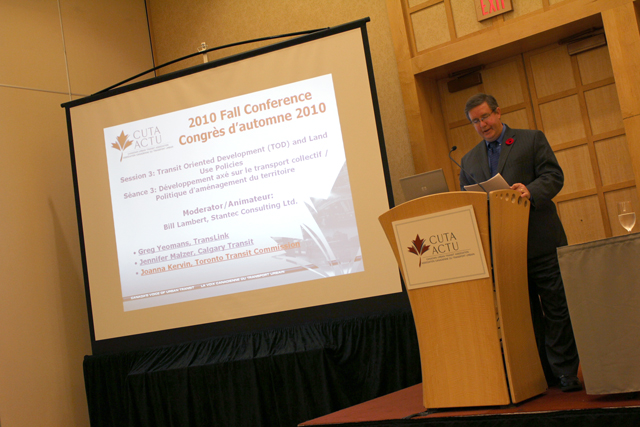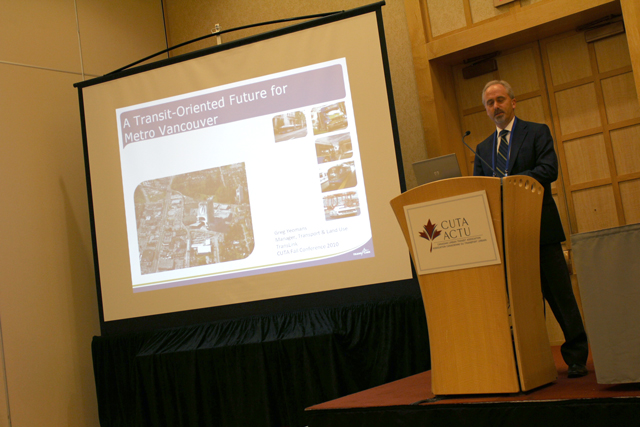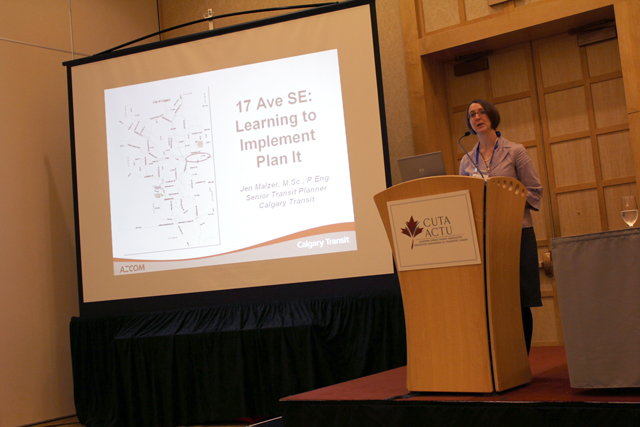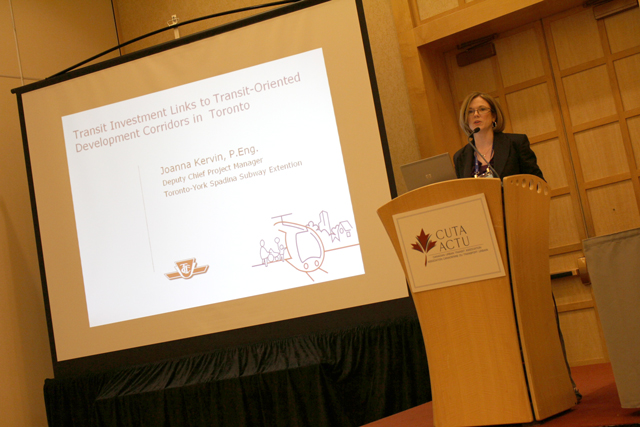CUTA 2010: Transit Oriented Development and Land Use Policies
CUTA 2010: Transit Oriented Development and Land Use Policies

As mentioned, the Canadian Urban Transit Association’s 2010 fall conference is in Vancouver this week! Thus I attended a morning session called Transit Oriented Development (TOD) and Land Use Policies — Positioning Transit at the Centre of Communities, featuring presentations by TransLink, Calgary Transit, and the Toronto Transit Commission (TTC).
Transit-oriented development is the creation of mixed-use commercial or residential areas where it’s easy to walk, cycle or take transit to reach the things you need. Everyone spoke to the challenge of matching transit plans to land-use plans made by cities, sister agencies, or other bodies in your region to help these developments happen. And as we all know, an effective transportation plan can’t really be made without the support of a good land-use plan to outline densities, adequate destinations, and more.
Herewith are my notes, and as always, corrections are welcome!
A Transit Oriented Future for Metro Vancouver

Greg Yeomans, TransLink’s manager of transit-oriented development planning, talked about the higher-level strategies we are looking at in Metro Vancouver. Mainly, our work is guided by the goals of Transport 2040, our long-range 30-year plan. Two goals of the plan resonate specifically with this work: most trips are by transit, walking and cycling, and the majority of jobs and housing are located along our Frequent Transit Network (FTN: the regional corridors where transit services is every 15 minutes, 15 hours a day, seven days a week.) The challenge is that currently transit, walking, and cycling trips make up only about 25 per cent of our region’s trips, and only about 47 per cent of our regional population are located along the FTN.
As well, one of the strategies outlined in Transport 2040 applies heavily to TOD: make early investments that encourage development of communities designed for transit, cycling, and walking. As Transport 2040 points out, population growth of about 1 million is expected in 30 years, and that growth is expected in the south and east sectors, and so important land-use choices need to be made now in those communities to ensure transit can accommodate these new people.
So, for the future, to move toward building transit oriented communities in our region, TransLink is working on both supply side and demand side objectives. Form the supply side, we are looking to invest in service and infrastructure, use our FTN as a catalyst, and improve transit supportive facilities and links. And from the demand side, we are looking to partner with the municipalities on developing transit-oriented land use, and better integrate transit facilities into the community.
There are obviously challenges ahead: one is that most large cities are in favour of TOD in their plans, but they don’t really have any strategies for implementation or measurement. Also, the idea that you can do transit-oriented development piecemeal is not really a solution: you need to put in a suite of changes—land use that encourages TOD, a quality transit supply, transit infrastructure and amenities, and transport demand management measurements—in order to reduce vehicle traffic and encourage transit use.
Greg’s concluding thoughts mentioned the following points: prioritize pedestrians in your plans, integrate land use and transit planning and infrastructure at the outset at all levels (or else you end up having to make costly adjustments down the road), and have a clear strategy backed up with actionable items. And last but not least, a motto: the best transportation plan is a land use plan.
17 Ave SE – Learning to Implement It

Jennifer Malzer from Calgary Transit discussed a transit-oriented development plan integrated into a corridor called 17 Ave SE in Calgary. Her focus was less on the actual results of the plan and more on the practical process of working with their land-use planning colleagues. They work under a city plan called Plan It Calgary, which links land use and transportation decisions. The plan focuses on corridors called Primary Transit Networks, with 10 minute transit service, 15 hours a day, seven days a week, and no specified mode. There is also a focus on local and regional “mobility hubs,” locations where transit-oriented development should be at its greatest.
The 17th Ave SE area is a 1950s/60s development that wanted to hold on to its heritage features (service roads, angled parking, small retail frontage). The challenge was to bring good transit to the corridor, and Jennifer emphasized that the final plan for a median busway was a good news story, championed by all partners and approved this year. The key lessons from the process shouldn’t serve to detract from that result! And those lessons included:
- Have a facilitator lead a lessons learned session—involve the public and consultants, it’s pretty invaluable
- Don’t take goal setting for granted—the goals for transit planning and land use were initially quite different
- Design projects for staff changeover—there were 10+ staffing changes over 3 years, and the project’s charter gave them little flexibility to adjust their work
- Flexibility—before consultants were brought in the transit side was championing one solution, which didn’t give the land use side much to work with
- Host an internal workshop—confirm your background info, identify issues, clarify the direction you want to head in. The land use planners didn’t realize that the transit side intended the existing traffic to remain on the corridor, which was important because 17 Ave is also Highway 1A in Calgary.
- A picture tells all—using pictures to communicate travel challenges on the corridor was key. A photo of a cyclist riding in front of a bus helped people understand that separate cycling facilities might be needed
- Too much computer modelling too early can be overwhelming
- Corporate properties—develop an acquisition plan early
Jennifer also included a slide that said “You know you’re not working together when… you have two program managers, two websites, two meetings set with aldermen, two sets of goals, and two report structures”! But to reiterate, the plan was ultimately a success!
Transit Investment Links to Transit Oriented Development in Other Communities

Joanna Kervin from the Toronto Transit Commission (TTC) talked about some of their recent projects and how that has affected related land-use developments in the city. (Fun fact about the TTC: it’s the third-largest system in North America with 470 million riders a year!)
Joanna described the City of Toronto’s official plan, under which they plan all transit and land-use developments in the city, and whose chief tenet is “No person in Toronto shall be disadvantaged by not owning a car.” Apparently more than 30 per cent of households in the Toronto area do not have a vehicle, and they want to continue to build a city that supports this choice. As well, did you know no new roads have been built in the city in 30 years? So transit growth is planned for major growth areas that still need access to great transportation.
So Toronto has a huge investment in transit—the Toronto-York-Spadina subway extension is a $2.6 billion partnership between Canada, Ontario, Toronto and the York Region, there’s a billion being put into new streetcars, and there’s over $10 billion being spent on the Transit City subway and LRT extensions.
How do they support this investment with proper land use? Well, for the Spadina extension, the six stations already identified in the City of York and City of Toronto plans, but secondary plans for York University and an area called Downsview that has a federal public park area. Both reconsidered their plans to include the stations and provided urban design guidelines for the station areas. (Btw, for York University, one of the subway stations will effectively replace 1700 buses going to campus. Yow!)
For Transit City, the planned transit developments mimic land use plans that identify neighbourhoods of importance, as the official plan looks to do city building, not just transportation planning. The vision is higher density neighbourhoods served by good transit. Joanna pointed out that LRT in the medians can build this density, as it has happened in Spadina, and the Sheppard Subway has also been a successful example of increased density, with jobs doubling in the station areas after the subway was put in.
Questions and answers!
Always a fun part! Here are some of the highlights.
Q: Relationship with landowners; how to steer them to develop transit-oriented developments?
Greg: TransLink has no authority on land use, so we’re not always the first point of contact. But we try to maintain close relations with the municipalities and make agreements with developers that incorporate both the municipality’s wishes and transportation needs. Sometimes developers will turn to each agency and try to make a deal individually, but that should be avoided. Share a lot of info with other authorities.
Joanna: Downsview—the federal park inside it, there was a challenge getting them to focus on the station area. They also have a large private airport there to consider. You just work as close as you can to develop around stations and have an ongoing discussion.
Jennifer: Timing is important. For local businesses we wanted to provide no uncertainty on how the planned median busway would affect their sites.
Q: I’m from the UK and there are questions there about capturing the planning value back from the land. That is, the land is more valuable now because we made specific transit-oriented plans for it. Do you have any thoughts on this?
Greg: Under our current legislation we can charge a “benefiting area tax” in areas that derive value from our work, but we don’t currently do this. It may be looked at seriously in our quest for stable funding. TransLink could also change its legislation so we can act more assertively to buy and sell properties and generate revenue.
Joanna: in Toronto, provincial legislation would allow for that, but there has been no movement on that topic.
Jennifer: Calgary is in the same situation as Toronto.
Q: What are two pieces of advice for agencies or municipalities looking to implement transit-oriented development?
Joanna: Plans must go hand in hand. Without land use policy integrated tightly I don’t know how you reach the vision, even if you have the best plan in the world. Also, make sure you engage the community early. Or by the time you have development applications come in, the community will fight you every step of the way.
Greg: Ideally you want a single plan from one authority mixing land use and transportation, but that’s never the case. Here in Vancouver we are a bit closer to that ideal, with two regional planning and transportation agencies. But land use and transportation plans must be maintained and updated every day, not once every five years. And transit agencies shouldn’t be too shy about making your land use plans known. Expect something back for your work, maybe investment, or specific types of land use. We need to be more assertive.
Jennifer: Educate all parties and the public—it’s really easy to lose people on what transit-oriented development is. And remember that every development is different. You can waste a lot of time or get it wrong in the planning process, or you can go back, get to know the area, and get it right.






[…] This post was mentioned on Twitter by Breaking News in Van, iSkytrain. iSkytrain said: CUTA 2010: Transit Oriented Development and Land Use Policies http://ff.im/-tOVY7 […]